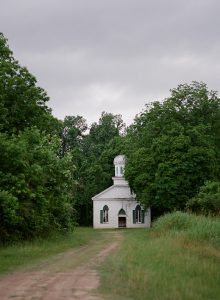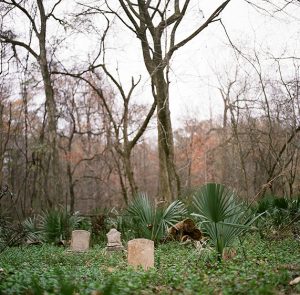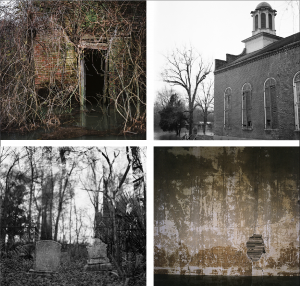When the Mississippi River rises – as it does every year – those who live along its banks call it “high water.” This is something expected, manageable: the water comes and washes clean its banks. The word “flood” is reserved only for the rarest occasions, maybe once in a generation.
[dropcap letter=”S”]o the rare winter floods that arrived in early 2016 were a kind of strange water. And Ashleigh Coleman knew what she wanted to do when it came: she borrowed a pair of waders and drove down to the famous riverside ghost town of Rodney. There amid the dawn light, she stepped into the flood.Coleman had learned about the town the year before, in 2015, as she planned a styled shoot for a wedding publication. She envisioned the shoot in an abandoned church, and her Google searches sent her straight to Rodney. On one of the hottest days that summer, Coleman and a wedding party, the bride ensconced in a $10,000 dress, tromped through the weeds and ruins. Coleman was struck by the architecture, particularly by the two churches – one brick and Presbyterian, the other white wood and Baptist – and returned on her own. It became a routine trip when family came from out of state: drive down to Rodney, explore, stop in for lunch at the Lorman Country Store. (The famous fried chicken is so good that now she’ll decline to eat chicken elsewhere.)
The town – which was founded in 1828 and abolished by gubernatorial proclamation in 1930 – suits Coleman’s aesthetic. “I think I like the sad things that have been used but aren’t used any longer,” she says. “How can I give them a second chance?”
Coleman, a Mississippi-based photographer whose work has been exhibited across the South, had previously documented an abandoned Methodist church in the small town of Toccopola, just outside of Oxford, where Coleman lived with her family for six and a half years. Rather than presenting a series of different scenes, as in a typical photo essay, the sequence shows the same church, often depicted from the same angle, over a series of different moments – a reminder that no object stays the same.
 Coleman said she was following the church’s “journey through the seasons,” and that last word is one she uses often. With her husband Josiah Coleman, a justice on the Mississippi Supreme Court, she has three children; their care occupies enough time that it can dictate her artistic process. For example, Coleman sends her photographs to a laboratory in California to be developed. She’s established a specific color profile with the laboratory, which gives each shot a similar look. “It was something I wrestled with a lot,” she says of that outsourcing. “It really boiled down to – I have three young children. I don’t have time right now. It’s okay. This is the season I’m in.”
Coleman said she was following the church’s “journey through the seasons,” and that last word is one she uses often. With her husband Josiah Coleman, a justice on the Mississippi Supreme Court, she has three children; their care occupies enough time that it can dictate her artistic process. For example, Coleman sends her photographs to a laboratory in California to be developed. She’s established a specific color profile with the laboratory, which gives each shot a similar look. “It was something I wrestled with a lot,” she says of that outsourcing. “It really boiled down to – I have three young children. I don’t have time right now. It’s okay. This is the season I’m in.”
She and photographer Ellen Rodgers – with whom she shared an exhibition at Jackson’s Fischer Galleries in January 2017 – sometimes take photography day trips together. But much of Coleman’s work is simply done in spare moments: shots of her family, of her neighbors, and of the ruins she discovers as she travels back roads. Coleman keeps a camera in the car at all times, she says. “I regularly pull over, take a shot, bribe the kids with bubble gum.” She is always looking: as we drove away from our lunch interview, we passed a large abandoned brick structure. Coleman hesitated, then decided the light wasn’t right.
Rodney sits thirty miles northeast of Natchez, and the first time I drove up I took back roads, winding down through the river bluffs. Eventually I found myself driving over rough dirt ruts, passing through bottomland farm fields. Feeling self-conscious and invasive, I doubted – and still doubt – that these were public roads. But it seemed appropriate to earn my arrival with a mud-spattered car: Rodney is a different world.
Yet it is not a lonely world, or it was not when I arrived. There were a few men at work on one of the raised trailers that have been installed on the edge of the historic town. While I wandered in and out of the churches, a couple arrived in an SUV, clearly on a Sunday excursion, and began to take photographs. This, really, is the nature of Rodney, at once a ghost town and yet still alive; two families remain, Coleman says, and on winter weekends deer hunters fill the nearby camps.
But when Coleman visited last winter, amid the floodwaters, Rodney was still – strikingly still. She could hear the water lapping at the edges of the buildings, and feel it lapping against her waders. She had grown familiar with the town from her many visits, and now it was transformed.

She later wrote that the experience was humbling, a reminder of “how small we are in the light of history and time.” We all have our season, in other words. Around us the river and the world remain, water flowing, floods falling and ebbing again, and we pass on.
By the late eighteenth century, European governments began to claim the country surrounding present-day Rodney, which passed successively through French, British, and Spanish hands. Finally, in 1798, it became the property of the United States. Through all these years, there were a few, tenuous settlements; as late as 1814 a popular guide to navigating the Mississippi listed no town worth stopping for. Nevertheless, an opening in the bluffs nearby created a convenient river, which attracted the beginnings of a town. By 1820 or so, Rodney, then known as Petit Gulf, was growing – if rugged. (Historical accounts depict bands of Choctaw Indians wandering its muddy streets.) The town was chartered in 1828, and by the 1850s had more than fifty stores, along with two banks and two newspapers.
But the years after the Civil War weren’t kind. The Mississippi River has a fickle path, ever-shifting, and in 1864, a sandbar began to form in front of Rodney. It grew and grew. (The town is now a few miles from the river.) Rodney’s doom was aided by a devastating fire in 1869; when railroads arrived nearby a decade later, drawing populations inland, the town was already largely empty. Just a few old-timers remained, gathering at the local store to swap stories, a practice that continued well past 1930, when Governor Theodore Bilbo revoked the town’s incorporation because of its population decline. In a river valley more than 10,000 years old, a hundred years of official townhood: that’s what constitutes Rodney’s short season on earth.
It might have been different. There’s an oft-repeated anecdote that in 1817, when Mississippi became a state, Rodney missed by three votes being named the capital.
What might that have meant? It’s a question implicit in Coleman’s photographs, a kind of memorial to other possibilities. “How drastically things change in 80 years,” she says. “Within a lifetime.”
Or within a year: Coleman met her husband, Josiah, seven years ago on a blind date she attended begrudgingly. He lived in Mississippi, she in South Carolina, and they were visiting a mutual friend in Nashville. Within nine months, Ashleigh had shelved plans for graduate school, moved to Mississippi, and was married.
Coleman, who studied literature and art history at the University of South Carolina, was interested in the Russian literary concept of “defamiliarization,” in which the ordinary is recast as strange. The move to Mississippi opened a new world of curiosities.
“Mississippi is still new to me,” Coleman says, six and a half years after moving to the state. “It still seems a little untamed. People back home ask me, ‘What’s Mississippi like?’ and I don’t know how to describe it other than that it’s a little wild. Unexpected things still happen here.”
Her arrival in the state coincided with a renewed interest in photography, an art she’d first tried in high school. She began to document her world – and, for pay, to shoot weddings. Three years ago, she began to experiment with film. On a family trip to Wyoming, her husband’s uncle offered her a Hasselblad 500c/m that had been gathering dust – a classic camera, first designed in the 1950s, that she continues to use as her primary camera. The switch to film, which pushed her to work with more purpose – metering the light, composing the shot – suited her interest in time. “I just like that it slows me down,” Coleman says. But it’s freeing, too, since she simply sends the film away to be develop, rather than being trapped for hours behind a computer’s editing software.
Working with film means that the images become physical artifacts – first negatives, then prints – rather than the ephemeral flash of social media across a screen. That materiality has taught Coleman to think more deeply about how the viewer will receive the work. In preparing for “Runes,” the exhibition at Jackson’s Fischer Galleries, Coleman says she learned so much about paper and how small choices can affect the image. “Even deciding what size you’re printing an image: is it going to be 24×24, or 8×8? That affects how a viewer sees your image,” she says. Some images should be smaller, and more intimate; some should be framed with no mat, which unsettling forces the viewer’s eye to stay within the edges.

Coleman prefers to frame her images with a mat, and use a heavy matte paper for printing – although for her color photographs in “Runes,” she chose paper with enough gloss to let the colors of the landscapes shine. The images, paper included, conjure the same themes as the series in Rodney: darkness, decay, and beauty at once. In the lead image for the exhibition, the hands of Merrimac, Coleman’s four-year-old daughter, are shown holding a dead bird. Here is the careful balance of mortality – life and death – as well as the balance of this season of Coleman’s life, in which her children and family become an intimate part of her art.
For someone so young – she is just 33 – Coleman seems to have a real awareness of mortality. Not that she is grim: the way she’s speaks about her current season – busy motherhood, with professional and artistic success squeezed into the moments that remain – makes it clear that she believes there will be another.
When I asked about that word, “season,” and why she uses it so often, I posited that it might have something to do with photography itself. A photograph, after all, is a record of the light that exists for the duration of a shutter’s click – a record of a tiny slice of time. But Coleman said she was inspired not by the individual clicks of the shutter, but instead by creating a lifetime body of work. She has been inspired by other photographers, particularly Southern women, mothers who did not rush their work: artists like Maude Schuyler Clay, from Sumner, MS, who after a long and successful career has reached a new height in her 60s, with a new photobook just released by one of the world’s most prestigious publishers.
“There is time,” Coleman says. “I don’t have to do it all right now. As long as I can be shooting, creating a body of work, I can do something with the work after the children are grown. That realization has given me a lot of freedom and contentment.”
You might call it the moral of Rodney: the river – the world – is always changing, but the town, like our lives, has its end. So make do with what you’ve got. It’s an outlook that demands humility, a humility that for Coleman is buttressed by her training in art history. She struggles to call herself an artist, she says. “Just two people from our generation might be remembered in art-history books,” she says. “Realistically, I am creating images because I enjoy it.”

If you read about Rodney, you sometimes encounter claims that are difficult to swallow: you’ll read, for example, that this tiny, pioneer village was the busiest port between New Orleans and St. Louis. Or that claim that the town nearly became the state capitol: it’s an improbable notion, given that Rodney then was little more than a rustic river landing. (It’s more likely that a poorly written history book has misled generations of readers, and that Petit Gulf, as the town was then named, was nearly named a territorial seat.) These inflations are supposed to deepen Rodney’s mystique, I suppose, by contrast, showing that something once so grand survives in just a few dilapidated ruins.
But when I visited Rodney, I did not need old grandeur to be moved. Here there is evidence that, amid the wildness of the world, we dig in. With the river rising around us, we build our homes, though we know that our season will pass quickly, and then high water will come again. What Coleman’s photographs teach us is to take notice. For there is beauty in that passing, in the very temporary fact of life, if only we open our eyes.
http://www.ashleighcoleman.com
Written by Boyce Upholt / Photography by Ashleigh Coleman
SaveSave
SaveSave
